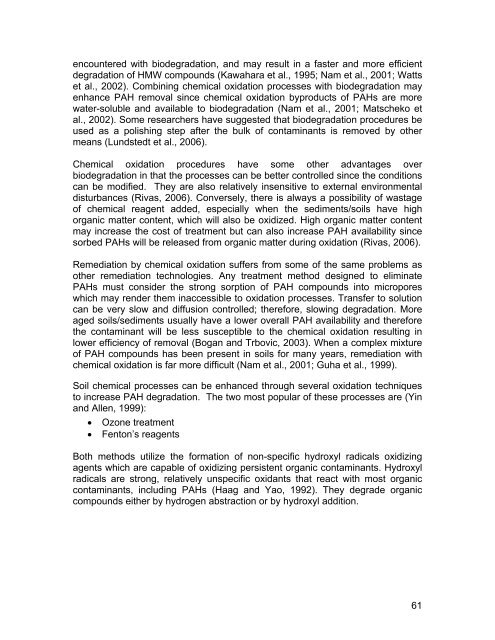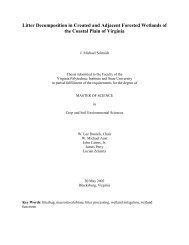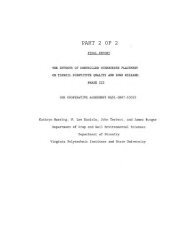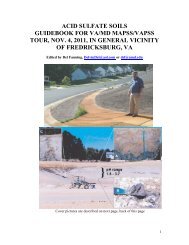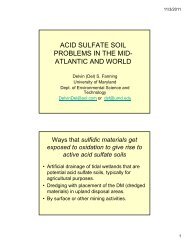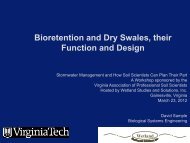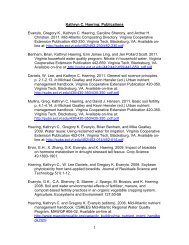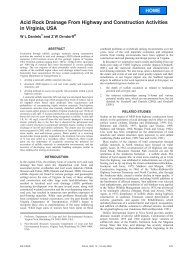Remediation of PAH-Contaminated Soils and Sediments: A ...
Remediation of PAH-Contaminated Soils and Sediments: A ...
Remediation of PAH-Contaminated Soils and Sediments: A ...
Create successful ePaper yourself
Turn your PDF publications into a flip-book with our unique Google optimized e-Paper software.
encountered with biodegradation, <strong>and</strong> may result in a faster <strong>and</strong> more efficient<br />
degradation <strong>of</strong> HMW compounds (Kawahara et al., 1995; Nam et al., 2001; Watts<br />
et al., 2002). Combining chemical oxidation processes with biodegradation may<br />
enhance <strong>PAH</strong> removal since chemical oxidation byproducts <strong>of</strong> <strong>PAH</strong>s are more<br />
water-soluble <strong>and</strong> available to biodegradation (Nam et al., 2001; Matscheko et<br />
al., 2002). Some researchers have suggested that biodegradation procedures be<br />
used as a polishing step after the bulk <strong>of</strong> contaminants is removed by other<br />
means (Lundstedt et al., 2006).<br />
Chemical oxidation procedures have some other advantages over<br />
biodegradation in that the processes can be better controlled since the conditions<br />
can be modified. They are also relatively insensitive to external environmental<br />
disturbances (Rivas, 2006). Conversely, there is always a possibility <strong>of</strong> wastage<br />
<strong>of</strong> chemical reagent added, especially when the sediments/soils have high<br />
organic matter content, which will also be oxidized. High organic matter content<br />
may increase the cost <strong>of</strong> treatment but can also increase <strong>PAH</strong> availability since<br />
sorbed <strong>PAH</strong>s will be released from organic matter during oxidation (Rivas, 2006).<br />
<strong>Remediation</strong> by chemical oxidation suffers from some <strong>of</strong> the same problems as<br />
other remediation technologies. Any treatment method designed to eliminate<br />
<strong>PAH</strong>s must consider the strong sorption <strong>of</strong> <strong>PAH</strong> compounds into micropores<br />
which may render them inaccessible to oxidation processes. Transfer to solution<br />
can be very slow <strong>and</strong> diffusion controlled; therefore, slowing degradation. More<br />
aged soils/sediments usually have a lower overall <strong>PAH</strong> availability <strong>and</strong> therefore<br />
the contaminant will be less susceptible to the chemical oxidation resulting in<br />
lower efficiency <strong>of</strong> removal (Bogan <strong>and</strong> Trbovic, 2003). When a complex mixture<br />
<strong>of</strong> <strong>PAH</strong> compounds has been present in soils for many years, remediation with<br />
chemical oxidation is far more difficult (Nam et al., 2001; Guha et al., 1999).<br />
Soil chemical processes can be enhanced through several oxidation techniques<br />
to increase <strong>PAH</strong> degradation. The two most popular <strong>of</strong> these processes are (Yin<br />
<strong>and</strong> Allen, 1999):<br />
� Ozone treatment<br />
� Fenton’s reagents<br />
Both methods utilize the formation <strong>of</strong> non-specific hydroxyl radicals oxidizing<br />
agents which are capable <strong>of</strong> oxidizing persistent organic contaminants. Hydroxyl<br />
radicals are strong, relatively unspecific oxidants that react with most organic<br />
contaminants, including <strong>PAH</strong>s (Haag <strong>and</strong> Yao, 1992). They degrade organic<br />
compounds either by hydrogen abstraction or by hydroxyl addition.<br />
61


